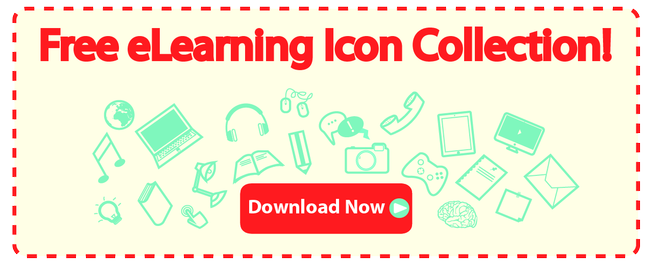 Effective learning doesn’t require expensive technology and elaborated training sessions. It doesn't even demand the impossible from you, the course developer. But it does call for a change in mindset.
Effective learning doesn’t require expensive technology and elaborated training sessions. It doesn't even demand the impossible from you, the course developer. But it does call for a change in mindset.
It’s key you set aside some time to observe and plan your eLearning strategy for the new year. Here are 24 statistics, tips and tricks that might make you rethink the way you're approaching eLearning:
1) eLearning is more than just presenting content and crossing fingers.
It's more than just creating attractive and interactive eLearning courses. It's about tapping into the experiences and emotions of your learners. It's about the images, the fonts and the words you carefully choose. About where and how you place content on the screen. About making it effective for your audience to absorb the most. About focusing less on how you can showcase your content, and more on how you can shape your audience's behavior. It's about all these things and so much more.
2) “70% of what we learn is through stories.”
Allan Fels, a highly regarded Australian professor, has talked about the power of storytelling. People don’t pay attention to boring things; they pay attention to emotions. Stories help the human mind understand, truly feel, and remember. So, if main points can be conveyed or at least reiterated by means of stories, with main characters and conflict, then attention and retention will be significantly increased.
3) Focus on activity, not screens.
Information is not evil but it doesn’t belong in a sardine can. Focus on screens and you’re in for a learning disaster.
4) Brain attention span is about 7-10 minutes.
Learners who are interested in a topic or subject can pay attention to it for about 7–10 minutes, and then their attention starts to wane. If they’re not interested, they will lose interest much sooner. All of these findings point out what’s obvious: short and simple messages are much more effective. So, don't ignore the realities of learners attention span and absorption rates: create bite-sized learning.
5) Design, first and foremost, is not about you.
No effective eLearning designer succeeded by putting their own needs first. If you want to offer learners something meaningful, then focus on them. Learn about your audience and involve them in the design process. Or as Kathy Sierra suggests: “Quit telling us how great you are, and start telling us how you plan to deliver something that helps the user become greater.”
6) Be careful with those images you use!
Some types of images are completely ignored by people. Studies reveal that “Users pay close attention to images that contain relevant information but ignore fluffy pictures used to "jazz up" Web pages”.
7) Practice makes one perfect.
When people stop practicing new things, the brain will eventually eliminate the connecting cells that formed the pathways. In other words, if you want learners to retain new information, you have to let them understand that only practice makes perfect. They’ll eventually lose a new skill unless they keep on practicing.
8) Create a distraction-free design.
Design is not decoration. Always bear this in mind. Effective design, after all, enables users to focus on the essentials; mere decoration distracts them.
9) Part of being an effective educator involves understanding how adults learn best (Lieb,1991.)
Adult learners are problem-centric, not content-centric. They invest time learning because they’re looking forward to get something useful out of it. If your eLearning course does not help them solve their issues, content will be forgotten.
10) Don’t make learners think!
Applying the principle doesn't mean students are not allowed to think while taking the course. It only means that good usability is obvious, self-explanatory, and intuitive. Users can quickly spot what they’re looking for and use a button or an element without needing to think.
11) Make your content stickier.
According to Chip and Dan Heath, authors of the book Made to Stick, for content to stick, it has to make people: Pay attention (to something unexpected), understand and remember it (because it’s concrete), believe in it (because it’s a credible idea), truly care about it (or make an emotional connection with it) and be able to act on it (by telling it as a story.)
12) 20% of content on an average web page is actually read.
People pick out words and sentences or scan pages instead. In eLearning, you can make it easier for readers to consume most of your content by: highlight keywords, use appropriate headings, write concise sentences and paragraphs, and utilize lists and bullet points.
13) Whatever you design, make sure it’s: Useful, Usable, and Desirable.
Usability, along with utility and desirability, unlocks the key to effective eLearning courses. By following these three essential principles, course developers are able to create great learning experiences for learners of all types.
14) Stick to the minimum information principle.
Simplicity is essential due to the way the brain works. Simple is beautiful, easy to understand, and is optimal for the learner whose main goal is to learn. Simple eLearning courses are easier to skim and scan for information. They are easier to navigate. And, they load faster.
15) Don't lose your learners- Keep their attention high.
What to do when you’re losing your learner’s attention? Introduce the element of change or novelty. Studies show that attention is at its highest when the instructor introduces something novel such as humor or a visual aid, thus breaking predicted behavior.
16) eLearning courses should not spoon-feed learners
The eLearning course should offer a wide variety of possibilities for exploring. Rather than feed learners content, design courses that allow them to explore concepts and ideas, try them out in different scenarios, and engage in inquiry based learning.
17) Color definitely matters!
Substantial research shows why color matters and how color plays a pivotal role in all our visual experiences. The right colors can help students improve their learning by as much as 75 percent, their participation by as much as 80 percent. Every shade and stroke of color, or the lack of it, creates its own message. It can make people feel relaxed, happy, excited or discouraged.
18) Do not steal control from the learner.
Treat learners as king or queen. They’re not prisoners. Adult learners, after all, sign up for eLearning courses so that they can learn at self-directed pace. Allow them to maneuver your material. Don’t force on them what you think is good for them.
19) Remember there is a human being who will be sitting at that computer...
Make sure that you are building conversations, that you are bringing eLearning experiences as close to in-person conversations as possible. Forget the passive, corporate-speak that will only distract learners. Instead, make your eLearning courses more personal and talk directly to the learner. Cammy Bean, industry expert, affirms that when we feel like an online experience is a conversation, we tend to pay more attention.
20) Always use an attractive design that's up-to-date and professional
"Attractive things work better" says Don Norman. If your eLearning courses look ugly, you're definitely starting with your left foot. First impressions matter and eye-pleasing content sells. Good design will help the students learn better while poor and ugly designs will make it difficult for them to get the right message.
21) Learning isn’t merely cognitive. It’s emotional, too.
Researchers, in fact, have confirmed how emotions affect mental processes. They finally found the missing piece of the learning puzzle and even encouraged instructional designers to include positive emotions as an important learning factor. If your course content connects with your learner’s emotions they are more likely to remember it.
22) Giving learners more than they need just clutters up the learning experience.
Our brain is designed to focus on or process a limited amount of information. So, provide your learners with bits of information. Tell them what they need to know and let them go. Otherwise, they are likely to ignore it or not finish it.
23) Are your courses content-centered... or audience-centered?
You are probably wondering what's the problem with your current eLearning slides. Alex Rister, communication expert, has a clear and simple answer: "The view that slides are for the presenter is exactly what’s wrong...An audience-centered instructor cares less about the number of bullets on a slide and more about how to successfully assist an audience in retaining information.”
24) Learning is all about motivation.
It is not that students cannot learn it's just that eLearning professionals spend too much time thinking about what students should know instead of focusing on what really motivates them. If you can understand what motivates learners, you can definitely enhance the learning experience.









